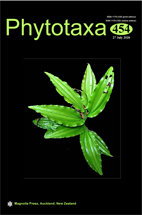Abstract
Many studies have focused on the taxonomy and phylogeny of the family Galaxauraceae with the use of molecular markers, allied to morphological taxonomy, providing a better understanding of the phylogenetic relationships within the family, as well assisting with the specific delimitation. For the Brazilian coast, Galaxauraceae has few studies with morphological taxonomy, but lack studies with a molecular focus. The diversity of Galaxauraceae was assessed in northeastern Brazil (Bahia state) using rbcL and COI-5P, as well as morpho-anatomical analyses. We report four species from Brazil: Dichotomaria huismanii (the first report for the Brazilian coast), D. obtusata, Galaxaura rugosa, and Tricleocarpa fragilis. Molecular and morphological data supported the establishment of two new species for Galaxauraceae: Tricleocarpa laxa sp. nov. and Dichotomaria viridis sp. nov. Tricleocarpa laxa formed a well-supported clade sister to T. natalensis (South Africa, type locality) and T. cylindrica (Australia) in both rbcL and COI-5P analyses, whereas Dichotomaria viridis, formed a moderate clade sister to D. huismanii. The Brazilian sequences of D. huismanii grouped with sequences from the type locality (Bermuda) showing no intraspecific divergence for rbcL, and very low divergence values for COI-5P. The record of D. huismanii in Brazil expands its geographical distribution to the South Atlantic Ocean. Male plants are described for the first time for this species. Even though our results are restricted to a region of northeastern Brazil (Bahia), they clearly revealed a hidden diversity of Galaxauraceae in Brazil.

